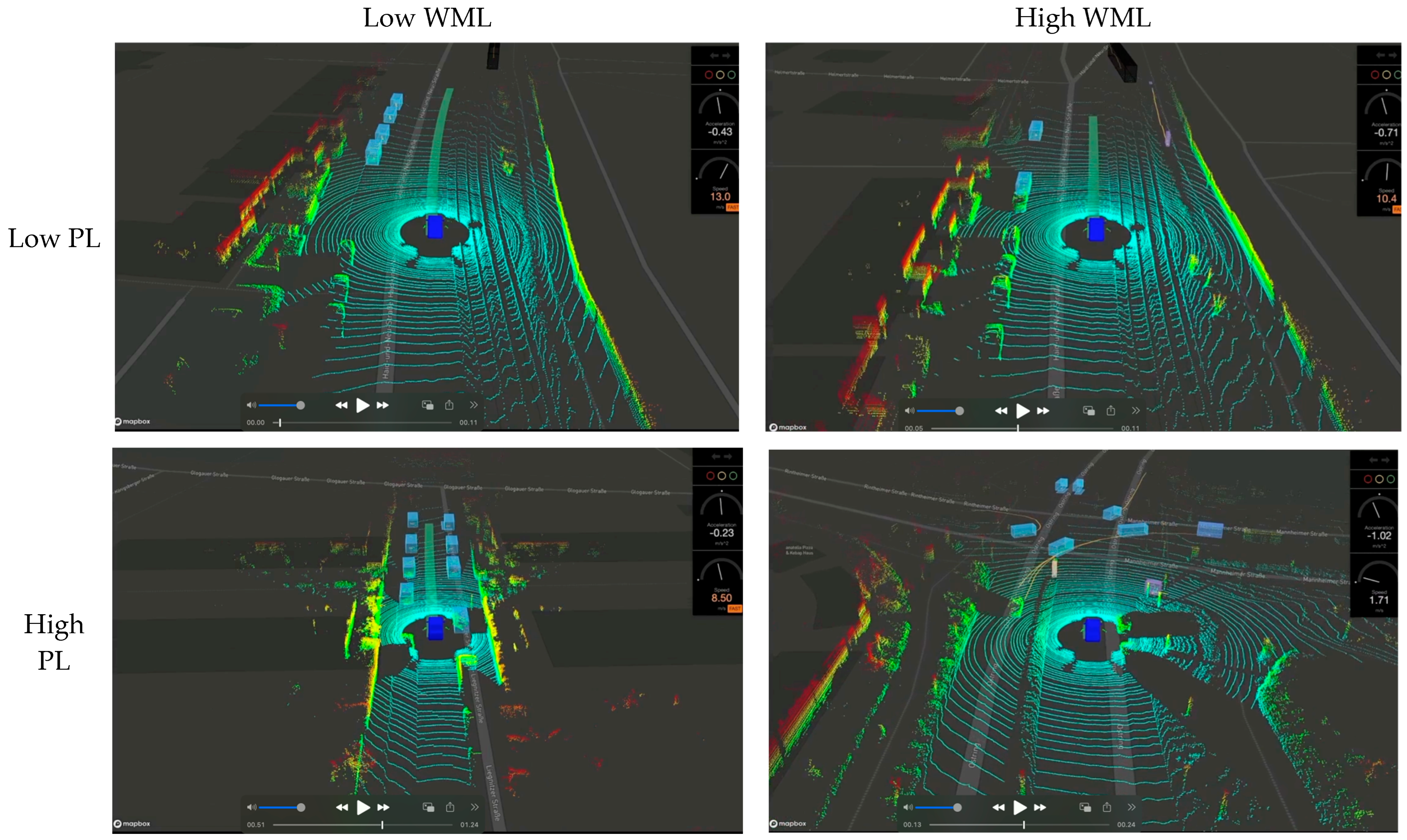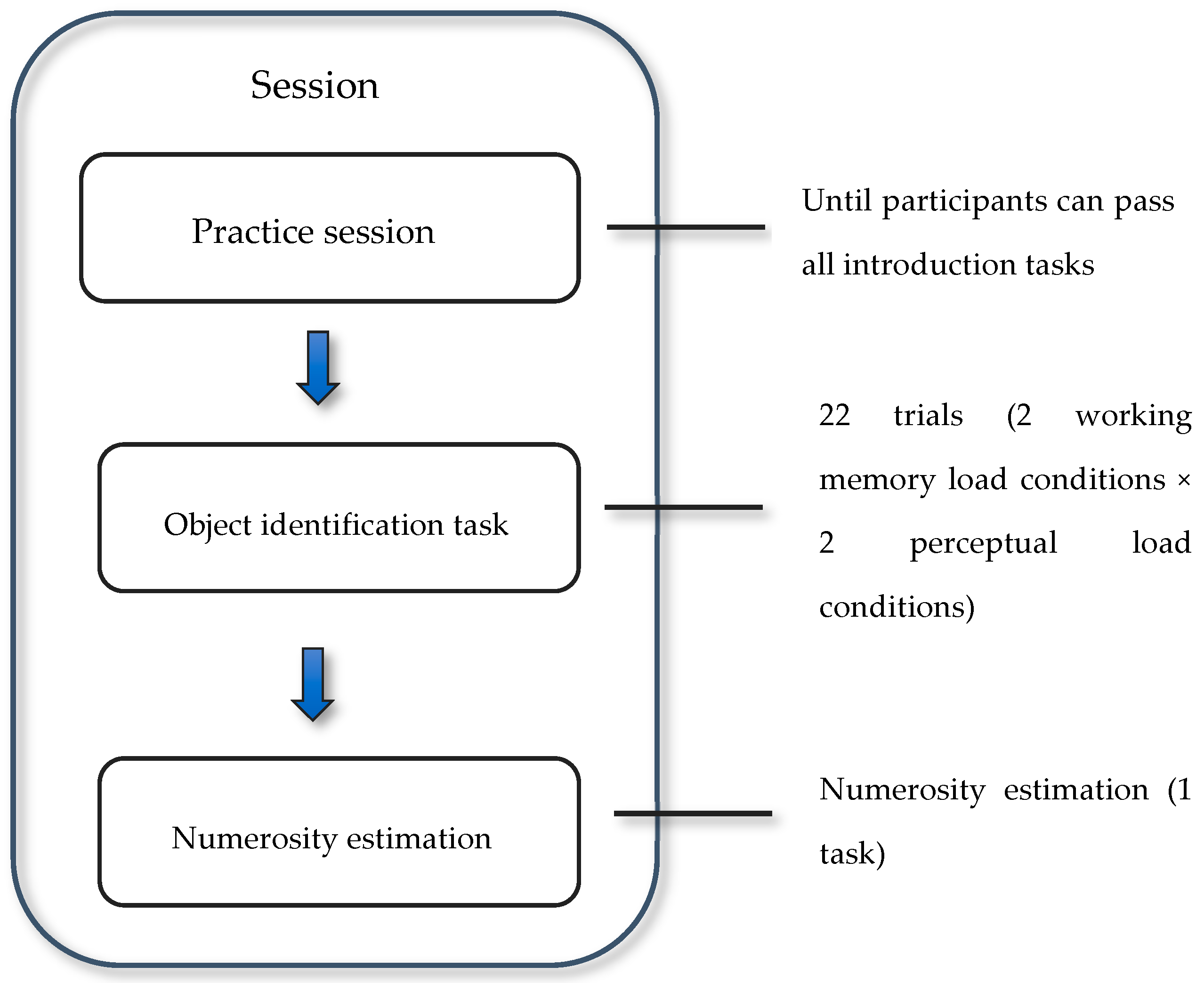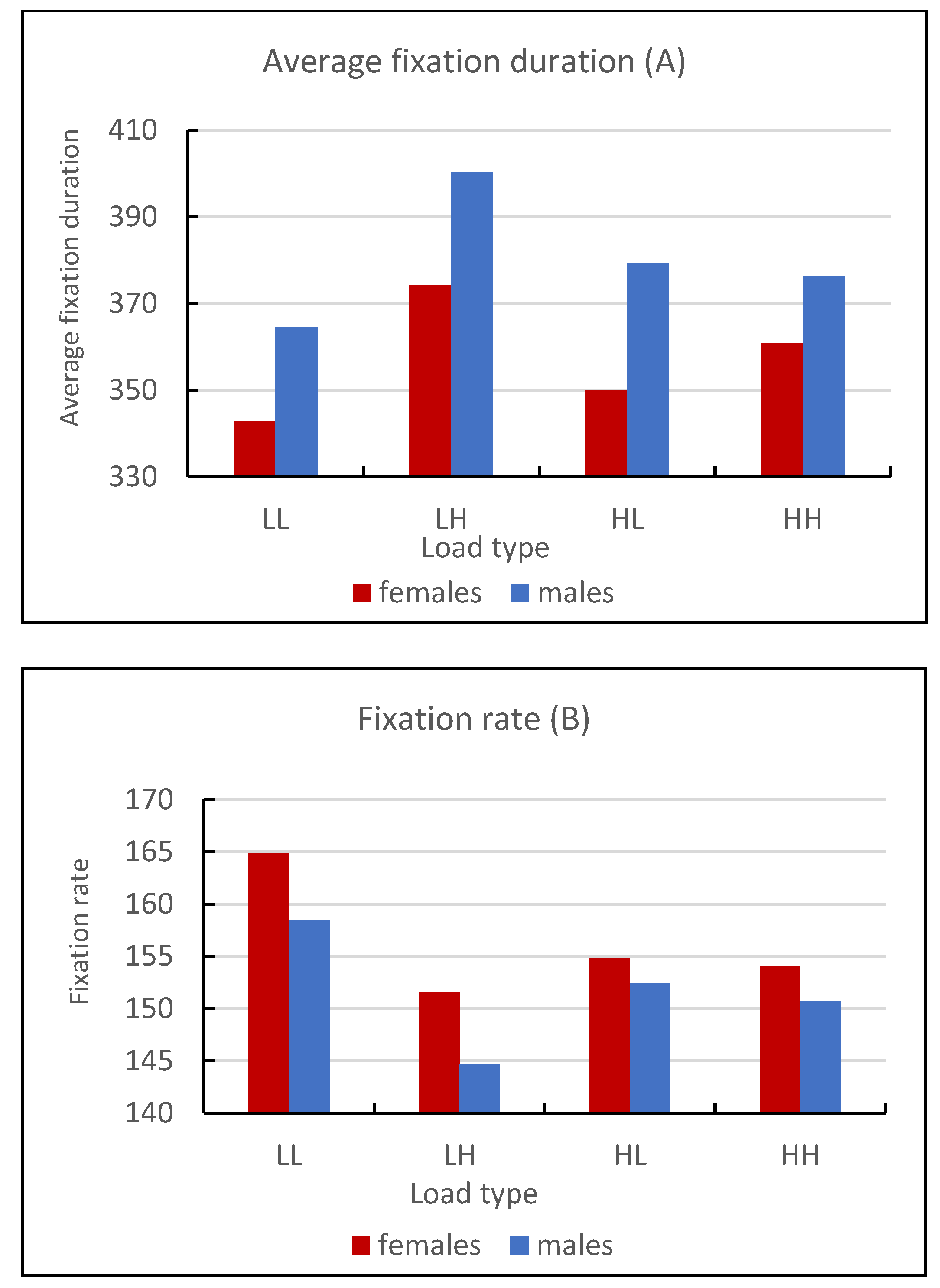Numerosity Perception and Perceptual Load: Exploring Sex Differences Through Eye-Tracking
Abstract
1. Introduction
1.1. Previous Explanations for Sex Differences in Numerosity Perception
1.2. Selective Attention as a Cause of Sex Difference in Numerosity Perception
1.3. Current Study
2. Methods
2.1. Participants
2.2. Materials
2.3. Procedure
2.4. Measurements
3. Results
3.1. Mental Load
3.2. Average Fixation Duration
3.3. Fixation Rate
3.4. Accuracy, Reaction Time, and Numerosity Estimation
4. Discussion
5. Limitations
6. Conclusions
Author Contributions
Funding
Institutional Review Board Statement
Informed Consent Statement
Data Availability Statement
Conflicts of Interest
References
- He, L.; Zhang, J.; Zhou, T.; Chen, L. Connectedness affects dot numerosity judgment: Implications for configural processing. Psychon. Bull. Rev. 2009, 3, 509–517. [Google Scholar] [CrossRef]
- Cicchini, G.M.; Anobile, G.; Burr, D. Spontaneous perception of numerosity in humans. Nat. Commun. 2016, 7. [Google Scholar] [CrossRef]
- Mazzocco, M.M.; Feigenson, L.; Halberda, J. Preschoolers’ precision of the approximate number system predicts later school mathematics performance. PLoS ONE 2011, 6, e23749. [Google Scholar] [CrossRef]
- Krueger, L.E. Single judgments of numerosity. Percept. Psychophys. 1982, 31, 175–182. [Google Scholar] [CrossRef] [PubMed]
- Gaulin, S.J.C.; Fitzgerald, R.W. Sex-differences in spatial ability—An evolutionary hypothesis and test. Am. Nat. 1986, 127, 74–88. [Google Scholar]
- Dong, W.; Zhan, Z.; Liao, H.; Meng, L.; Liu, J. Assessing Similarities and Differences between Males and Females in Visual Behaviors in Spatial Orientation Tasks. ISPRS Int. J. Geo-Inf. 2020, 9, 115. [Google Scholar] [CrossRef]
- Yuan, L.; Kong, F.; Luo, Y.; Zeng, S.; Lan, J.; You, X. Gender Differences in Large-Scale and Small-Scale Spatial Ability: A Systematic Review Based on Behavioral and Neuroimaging Research. Front. Behav. Neurosci. 2019, 13, 128. [Google Scholar] [CrossRef]
- Casey, M.B.; Nuttall, R.; Pezaris, E.; Benbow, C.P. The Influence of Spatial Ability on Gender Differences in Mathe-matics College Entrance Test Scores across Diverse Samples. Dev. Psychol. 1995, 31, 697–705. [Google Scholar] [CrossRef]
- Yuan, J.; He, Y.; Qinglin, Z.; Chen, A.; Li, H. Gender differences in behavioral inhibitory control: ERP evidence from a two-choice oddball task. Psychophysiology 2008, 45, 986–993. [Google Scholar] [CrossRef]
- Pagnotta, M.F.; Pascucci, D.; Plomp, G. Selective attention involves a feature-specific sequential release from inhibitory gating. Neuroimage 2022, 246, 118782–118795. [Google Scholar] [CrossRef]
- Neumann, E.; DeSchepper, B.G. Costs and benefits of target activation and distractor inhibition in selective attention. J. Exp. Psychol. Learn. Mem. Cogn. 1991, 17, 1136–1145. [Google Scholar] [CrossRef]
- Van Moorselaar, D.; Slagter, H.A. Inhibition in selective attention. Ann. N. Y. Acad. Sci. 2020, 1464, 204–221. [Google Scholar] [CrossRef] [PubMed]
- Jensen, O.; Mazaheri, A. Shaping functional architecture by oscillatory alpha activity: Gating by inhibition. Front. Hum. Neurosci. 2010, 4, 186. [Google Scholar] [CrossRef]
- Riley, E.; Okabe, H.; Germine, L.; Wilmer, J.; Esterman, M.; DeGutis, J. Gender Differences in Sustained Attentional Control Relate to Gender Inequality across Countries. PLoS ONE 2016, 11, e0165100. [Google Scholar] [CrossRef]
- Li, C.S.; Zhang, S.; Duann, J.R.; Yan, P.; Sinha, R.; Mazure, C.M. Gender Differences in Cognitive Control: An Extend-ed Investigation of the Stop Signal Task. Brain Imaging Behav. 2009, 3, 262–276. [Google Scholar] [CrossRef] [PubMed]
- Mansouri, F.A.; Fehring, D.J.; Gaillard, A.; Jaberzadeh, S.; Parkington, H. Sex dependency of inhibitory control functions. Biol. Sex Differ. 2016, 7, 11. [Google Scholar] [CrossRef]
- Lavie, N.; Hirst, A.; de Fockert, J.W.; Viding, E. Load Theory of Selective Attention and Cognitive Control. J. Exp. Psychol. Gen. 2004, 133, 339–354. [Google Scholar] [CrossRef]
- Bend, J.; Öörni, A. Effects of Augmented Reality on Visuospatial Abilities of Males and Females. In Computing, Internet of Things and Data Analytics. ICCIDA 2023; García Márquez, F.P., Jamil, A., Ramirez, I.S., Eken, S., Hameed, A.A., Eds.; Studies in Computational Intelligence; Springer: Cham, Switzerland, 2024; Volume 1145. [Google Scholar] [CrossRef]
- Bend, J.; Öörni, A. Exploring Inter-Sex Differnces in numerosity perception and cognitive load. IJEP Int. J. Eng. Padagog. 2024, 14, 125. [Google Scholar] [CrossRef]
- König, P.; Wilming, N.; Kietzmann, T.C.; Ossandón, J.P.; Onat, S.; Ehinger, B.V.; Gameiro, R.R.; Kaspar, K. Eye movements as a window to cognitive processes. J. Eye Mov. Res. 2016, 9. [Google Scholar] [CrossRef]
- Geiger, A.; Lenz, P.; Stiller, C.; Urtasun, R. Vision meets robotics: The kitti dataset. Int. J. Robot. Res. 2013, 32, 1231–1237. [Google Scholar] [CrossRef]
- Liu, J.C.; Li, K.A.; Yeh, S.L.; Chien, S.Y. Assessing Perceptual Load and Cognitive Load by Fixation-Related Information of Eye Movements. Sensors 2022, 22, 1187. [Google Scholar] [CrossRef] [PubMed]
- Charles, R.L.; Nixon, J. Measuring mental load using physiological measures: A systematic review. Appl. Ergon. 2019, 74, 221–232. [Google Scholar] [CrossRef] [PubMed]
- Tao, D.; Tan, H.; Wang, H.; Zhang, X.; Qu, X.; Zhang, T. A Systematic Review of Physiological Measures of Mental Load. Int. J. Environ. Res. Public Health 2019, 16, 2716. [Google Scholar] [CrossRef]
- Andrzejewska, M.; Stolińska, A. Comparing the Difficulty of Tasks Using Eye Tracking Combined with Subjective and Behavioural Criteria. J. Eye Mov. Res. 2016, 9. [Google Scholar] [CrossRef]
- Holmquist, K.; Nyström, M.; Andersson, R.; Dewhurst, R.; Jarodzka, H.; van de Weijer, J. Eye Tracking: A Comprehensive Guide to Methods and Measures; Oxford University Press: Oxford, UK, 2011. [Google Scholar]
- Henderson, J.M.; Choi, W. Neural Correlates of Fixation Duration during Real-world Scene Viewing: Evidence from Fixation-related (FIRE) fMRI. J. Cogn. Neurosci. 2015, 27, 1137–1145. [Google Scholar] [CrossRef]
- Van Orden, K.F.; Lambert, W.; Mäkelig, S.; Jung, T.P. Eye activity correlates of load during visuospatial memory task. Hum. Factors 2001, 43, 111–121. [Google Scholar] [CrossRef]
- Tang, H.; Day, E.; Kendhammer, L.; Moore, J.N.; Brown, S.A.; Pienta, N.J. Eye Movement Patterns in Solving Science Ordering Problems. J. Eye Mov. Res. 2016, 9. [Google Scholar] [CrossRef]
- Mallick, R.; Slayback, D.; Touryan, J.; Ries, A.J.; Lance, B.J. The use of eye metrics to index cognitive load in video games. In Proceedings of the 2016 IEEE Second Workshop on Eye Tracking and Visualization (ETVIS); 2016; pp. 60–64. [Google Scholar] [CrossRef]
- Di Stasi, L.L.; Antolí, A.; Cañas, J.J. Evaluating mental load while interacting with computer-generated artificial environments. Entertain. Comput. 2013, 4, 63–69. [Google Scholar] [CrossRef]
- Recarte, M.A.; Nunes, L.M. Effects of verbal and spatial-imagery tasks on eye fixations while driving. J. Exp. Psychol. Appl. 2000, 6, 31–43. [Google Scholar] [CrossRef]
- Nakayama, M.; Takahashi, K.; Shimizu, Y. The act of task difficulty and eye-movement frequency for the ‘Oculomotor indices’. In Proceedings of the 2002 Symposium on Eye-Tracking Research & Applications, New Orleans, LA, USA, 25–27 March 2002; pp. 37–42. [Google Scholar] [CrossRef]
- Gray, S.A.; Reeve, R.A. Preschoolers’ Dot Enumeration Abilities Are Markers of Their Arithmetic Competence. PLoS ONE 2014, 9, e94428. [Google Scholar] [CrossRef]
- Melcher, D.; Piazza, M. The role of attentional priority and saliency in determining capacity limits in enumeration and visual working memory. PLoS ONE 2011, 6, e29296. [Google Scholar] [CrossRef] [PubMed]
- Piazza, M.; Fumarola, A.; Chinello, A.; Melcher, D. Subitizing reflects visuo-spatial object individuation capacity. Cognition 2011, 121, 147–153. [Google Scholar] [CrossRef]
- Wutz, A.; Melcher, D. Temporal buffering and visual capacity: The time course of object formation underlies capacity limits in visual cognition. Atten. Percept. Psychophys. 2013, 75, 921–933. [Google Scholar] [CrossRef][Green Version]
- Trick, L.M.; Audet, D.; Dales, L. Age differences in enumerating things that move: Implications for the development of multiple-object tracking. Mem. Cogn. 2003, 31, 1229–1237. [Google Scholar] [CrossRef] [PubMed]
- Wienrich, C.; Heße, U.; Müller-Plath, G. Eye movements and attention in visual feature search with graded target-distractor-similarity. J. Eye Mov. Res. 2009, 3. [Google Scholar] [CrossRef]
- Murthy, G.; Groeger, J.A.; Greene, C.M. Twenty years of load theory—Where are we now, and where should we go next? Psychon. Bull. Rev. 2016, 23, 1316–1340. [Google Scholar] [CrossRef]
- Torralbo, A.; Beck, D.M. Perceptual load-induced selection as a result of local competitive interactions in visual cortex. Psychol. Sci. 2008, 19, 1045–1050. [Google Scholar] [CrossRef]
- Dye MW, G.; Green, C.S.; Bavelier, D. The development of attention skills in action video game players. Neuropsychologia 2009, 47, 1780–1789. [Google Scholar] [CrossRef]
- Green, C.S.; Bavelier, D. Action video games modify visual selective attention. Nature 2003, 423, 534–537. [Google Scholar] [CrossRef]
- Green, C.S.; Bavelier, D. Effects of action video game playing on the spatial distribution of visual selective attention. J. Exp. Psychol. Hum. Percept. Perform. 2006, 32, 1465–1478. [Google Scholar] [CrossRef]
- Feng, J.; Spence, I.; Pratt, J. Playing an action videogame reduces gender differences in spatial cognition. Psychol. Sci. 2007, 18, 850–855. [Google Scholar] [CrossRef] [PubMed]
- Li, R.; Polat, U.; Makous, W.; Bavelier, D. Enhancing the contrast sensitivity function through action video game training. Nat. Neurosci. 2009, 12, 549–551. [Google Scholar] [CrossRef] [PubMed]
- Unsworth, N.; Redick, T.S.; McMillan, B.D.; Hambrick, D.Z.; Kane, M.J.; Engle, R.W. Is Playing Video Games Related to Cognitive Abilities? Psychol. Sci. 2015, 26, 759–774. [Google Scholar] [CrossRef] [PubMed]
- Kristjánsson, Á. The case for causal influences of action videogame play upon vision and attention. Atten. Percept. Psychophys. 2013, 75, 667–672. [Google Scholar] [CrossRef]
- Bediou, B.; Adams, D.M.; Mayer, R.E.; Tipton, E.; Green, C.S.; Bavelier, D. Meta-analysis of action video game impact on perceptual, attentional, and cognitive skills. Psychol. Bull. 2018, 144, 77–110. [Google Scholar] [CrossRef]
- De Rivecourt, M.; Kuperus, M.N.; Post, W.J.; Mulder, L.J. Cardiovascular and eye activity measures as indices for momentary changes in mental effort during simulated flight. Ergonomics 2008, 51, 1295–1319. [Google Scholar] [CrossRef]
- Foy, H.J.; Chapman, P. Mental load is reflected in driver behaviour, physiology, eye movements and prefrontal cortex activation. Appl. Ergon. 2018, 73, 90–99. [Google Scholar] [CrossRef]
- Svensson, E.A.I.; Wilson, G.F. Psychological and psychophysiological models of pilot performance for systems development and mission evaluation. Int. J. Aviat. Psychol. 2009, 12, 95–110. [Google Scholar] [CrossRef]
- Di Stasi, L.L.; Antolí, A.; Gea, M.; Cañas, J.J. A neuroergonomic approach to evaluating mental load in hypermedia interactions. Int. J. Ind. Ergon. 2011, 41, 298–304. [Google Scholar] [CrossRef]



| Variable | Mann–Whitney U Test by Variable Sex. Marked Tests are Significant at p < 0.05 | ||||||
|---|---|---|---|---|---|---|---|
| Rank Sum Females | Rank Sum Males | U | Z | p-Value | Valid N Females | Valid N Males | |
| Average fixation duration | 57,854.0 | 49,099.0 | 22,874.0 | −2.3 | 0.022 | 264 | 198 |
| Fixation rate (per minute) | 64,292.5 | 42,660.5 | 22,959.5 | −2.2 | 0.025 | 264 | 198 |
| Variable | Aggregate Results’ Descriptive Statistics | ||||||||
|---|---|---|---|---|---|---|---|---|---|
| Sex | N trials | Mean | Median | Minimum | Maximum | Variance | Std.Dev. | Coef.Var. | |
| Average fixation duration | Females | 264 | 357.36 | 342.72 | 226.23 | 788.11 | 5391.19 | 73.42 | 20.55 |
| Fixation rate (per minute) | Females | 264 | 156.59 | 157.06 | 74.83 | 235.02 | 637.99 | 25.26 | 16.13 |
| Average fixation duration | Males | 198 | 377.69 | 360.42 | 190.67 | 804.37 | 9895.53 | 99.48 | 26.34 |
| Fixation rate (per minute) | Males | 198 | 151.88 | 152.80 | 70.43 | 272.73 | 1065.22 | 32.64 | 21.49 |
Disclaimer/Publisher’s Note: The statements, opinions and data contained in all publications are solely those of the individual author(s) and contributor(s) and not of MDPI and/or the editor(s). MDPI and/or the editor(s) disclaim responsibility for any injury to people or property resulting from any ideas, methods, instructions or products referred to in the content. |
© 2025 by the authors. Licensee MDPI, Basel, Switzerland. This article is an open access article distributed under the terms and conditions of the Creative Commons Attribution (CC BY) license (https://creativecommons.org/licenses/by/4.0/).
Share and Cite
Bend, J.; Öörni, A. Numerosity Perception and Perceptual Load: Exploring Sex Differences Through Eye-Tracking. J. Eye Mov. Res. 2025, 18, 9. https://doi.org/10.3390/jemr18020009
Bend J, Öörni A. Numerosity Perception and Perceptual Load: Exploring Sex Differences Through Eye-Tracking. Journal of Eye Movement Research. 2025; 18(2):9. https://doi.org/10.3390/jemr18020009
Chicago/Turabian StyleBend, Julia, and Anssi Öörni. 2025. "Numerosity Perception and Perceptual Load: Exploring Sex Differences Through Eye-Tracking" Journal of Eye Movement Research 18, no. 2: 9. https://doi.org/10.3390/jemr18020009
APA StyleBend, J., & Öörni, A. (2025). Numerosity Perception and Perceptual Load: Exploring Sex Differences Through Eye-Tracking. Journal of Eye Movement Research, 18(2), 9. https://doi.org/10.3390/jemr18020009






